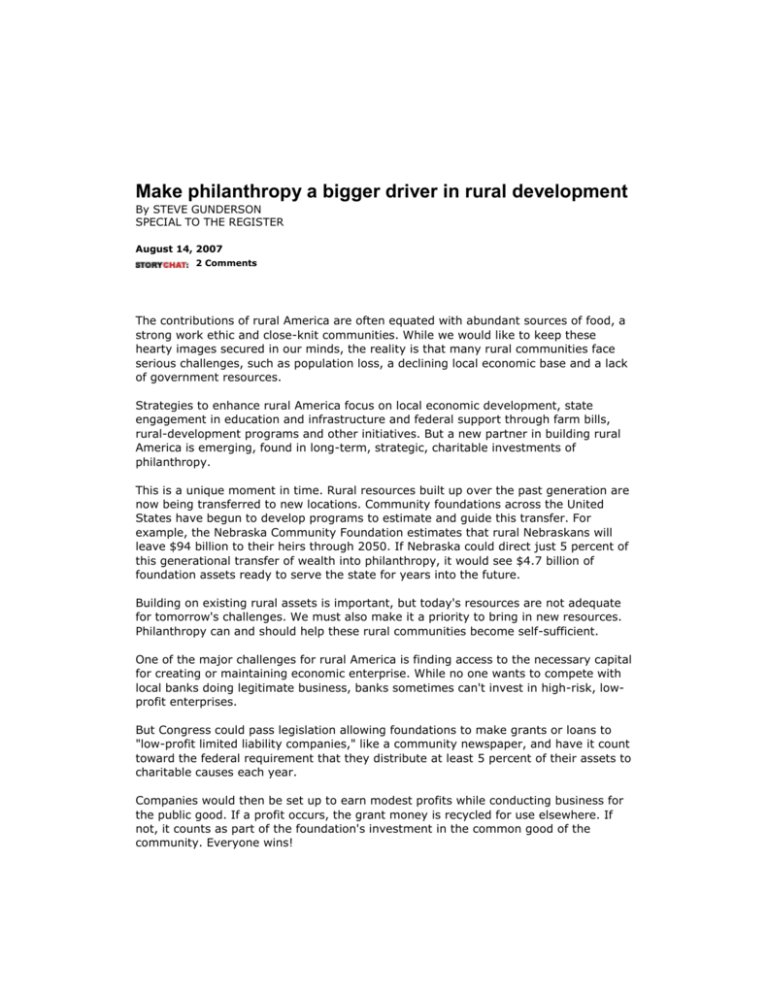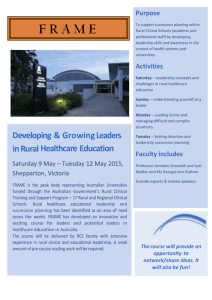Make philanthropy a bigger driver in rural development
advertisement

Make philanthropy a bigger driver in rural development By STEVE GUNDERSON SPECIAL TO THE REGISTER August 14, 2007 2 Comments The contributions of rural America are often equated with abundant sources of food, a strong work ethic and close-knit communities. While we would like to keep these hearty images secured in our minds, the reality is that many rural communities face serious challenges, such as population loss, a declining local economic base and a lack of government resources. Strategies to enhance rural America focus on local economic development, state engagement in education and infrastructure and federal support through farm bills, rural-development programs and other initiatives. But a new partner in building rural America is emerging, found in long-term, strategic, charitable investments of philanthropy. This is a unique moment in time. Rural resources built up over the past generation are now being transferred to new locations. Community foundations across the United States have begun to develop programs to estimate and guide this transfer. For example, the Nebraska Community Foundation estimates that rural Nebraskans will leave $94 billion to their heirs through 2050. If Nebraska could direct just 5 percent of this generational transfer of wealth into philanthropy, it would see $4.7 billion of foundation assets ready to serve the state for years into the future. Building on existing rural assets is important, but today's resources are not adequate for tomorrow's challenges. We must also make it a priority to bring in new resources. Philanthropy can and should help these rural communities become self-sufficient. One of the major challenges for rural America is finding access to the necessary capital for creating or maintaining economic enterprise. While no one wants to compete with local banks doing legitimate business, banks sometimes can't invest in high-risk, lowprofit enterprises. But Congress could pass legislation allowing foundations to make grants or loans to "low-profit limited liability companies," like a community newspaper, and have it count toward the federal requirement that they distribute at least 5 percent of their assets to charitable causes each year. Companies would then be set up to earn modest profits while conducting business for the public good. If a profit occurs, the grant money is recycled for use elsewhere. If not, it counts as part of the foundation's investment in the common good of the community. Everyone wins! As part of the farm bill's focus on rural development, Congress should specify that foundation money can qualify as part of the local matching funds required to get federal money for rural-development projects. One area for increased attention: job training in rural areas. Republican Sen. Chuck Grassley of Iowa and Democrat Max Baucus of Montana have led the nation's efforts to improve the conduct of the nation's nonprofit sector. The next step in this effort might be a partnership in growing philanthropy's role in building rural America. Philanthropic leaders and grant makers from around the country gathered last week in Missoula, Mont., to develop a first-ever agenda for philanthropy and rural America. The goal is to create sustained resources for future investment in building community and to build partnerships among the public, private and philanthropic sectors to enhance results. Working together is a long-standing tenet of life in rural America. By enhancing the regional visions of grant makers, while building new philanthropic resources, we can grow this charitable investment in rural America's future. STEVE GUNDERSON is CEO and president of the Council on Foundations in Washington, D.C., and was an eight-term U.S. congressman from Wisconsin.






